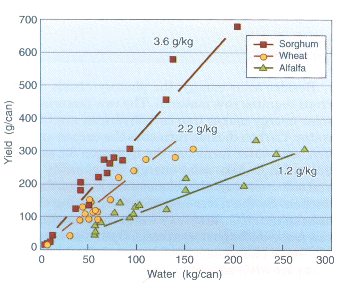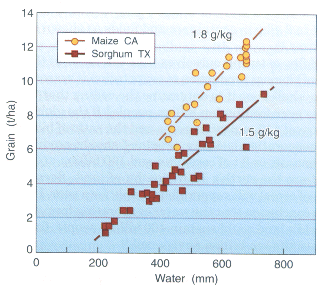Although photosynthesis incorporates little water
into carbohydrates, it consumes much. The moist site
of photosynthesis within the leaf must receive the raw
material ![]() . Concomitantly, water escapes or transpires
through the same pores or stomata admitting
the
. Concomitantly, water escapes or transpires
through the same pores or stomata admitting
the ![]() . Measured in the units of precipitation, transpiration
from a crop can consume 7 mm/day.
. Measured in the units of precipitation, transpiration
from a crop can consume 7 mm/day.![]() In California during a season,
evapotranspiration --evaporation
from the soil plus transpiration
by the
crop-totaled about 700 mm (Stewart et al., 1977[SHP
In California during a season,
evapotranspiration --evaporation
from the soil plus transpiration
by the
crop-totaled about 700 mm (Stewart et al., 1977[SHP![]() 77]
207). The magnitude of the 700 mm is grasped better
if stated in weight of water/ha: 7,000 tons. How
low a ceiling does the global sum of fresh water place
over crop production for ten billion people?
77]
207). The magnitude of the 700 mm is grasped better
if stated in weight of water/ha: 7,000 tons. How
low a ceiling does the global sum of fresh water place
over crop production for ten billion people?
Speaking teleologically, I can say that Evolution
has noticed transpiration
and has taken measures to
reduce consumption of water. Its measures are cells
that guard the stomatal entrances to the leaf. Generally,
the guards narrow the entrances when abundant ![]() ,
deficient water. or darkness signal that
transpiration can be slowed while scarcely slowing
photosynthesis. Sinclair, Tanner, and Bennett argue
that biomass accumulation
is ``inextricably linked to
transpiration",
and Cowan goes so far as to propose
that plants dynamically adjust their stomata to maintain
an optimal balance between photosynthesis and
transpiration
(Cowan, 1977[Cow77]; Sinclair et al., 1984[STB84]). The
point is that although transpired water is not incorporated
into carbohydrate, consumption of water inevitably
accompanies photosynthesis. Thinking about
physical limits hemming in food production,
I cannot escape considering water supply as well
as solar energy and
,
deficient water. or darkness signal that
transpiration can be slowed while scarcely slowing
photosynthesis. Sinclair, Tanner, and Bennett argue
that biomass accumulation
is ``inextricably linked to
transpiration",
and Cowan goes so far as to propose
that plants dynamically adjust their stomata to maintain
an optimal balance between photosynthesis and
transpiration
(Cowan, 1977[Cow77]; Sinclair et al., 1984[STB84]). The
point is that although transpired water is not incorporated
into carbohydrate, consumption of water inevitably
accompanies photosynthesis. Thinking about
physical limits hemming in food production,
I cannot escape considering water supply as well
as solar energy and ![]() .
.
If transpiration
must accompany photosynthesis
and if stomata have balanced the two processes, they
should change in step. The correlation between the
two is furthered because radiation, wholly solar for
photosynthesis and largely solar for transpiration,
energizes both. So a connection between transpiration
and photosynthesis should permit a rough calculation of yield
from evaporation. Over a generation
ago, deWit (1958[deW58]) tested the connection, using observations
from early in the twentieth century. Figure 6.3.1
shows that the dry weight of a shoot increases
with transpiration.
The shoot is all of the plant above
ground and may be thought of as biomass. The harvest
index, or ratio of grain to biomass, is about half.![]() Because the soil was covered to prevent evaporation
from the soil surface, the loss of water can accurately
be called transpiration.
Although the observed
plants grew in containers, making the dimensions of
photosynthesis and transpiration grams/container or
`can', the ratio of biomass or shoot to transpiration
has the general dimensions of g biomass/kg water.
Because the soil was covered to prevent evaporation
from the soil surface, the loss of water can accurately
be called transpiration.
Although the observed
plants grew in containers, making the dimensions of
photosynthesis and transpiration grams/container or
`can', the ratio of biomass or shoot to transpiration
has the general dimensions of g biomass/kg water.
 Figure 6.3.1. The production of dry weight of a shoot, as a
function of transpiration. The three species of crop
were grown in containers in the Great Plains and
India (adapted from deWit, 1958).[deW58]
Figure 6.3.1. The production of dry weight of a shoot, as a
function of transpiration. The three species of crop
were grown in containers in the Great Plains and
India (adapted from deWit, 1958).[deW58]
On Figure 6.3.1 I have written the slopes 3.6, 2.2, and 1.2 g/kg of three lines fitted to the point of `no transpiration, no yield' and the observations of the three species in the two dry climates. In the moister climate of the Netherlands, deWit (1958[deW58]) estimated oats, 2.6; peas, 3.4; and beets, 6.1 g biomass/kg evapotranspiration.
``At first approximation [the g biomass/kg water were] independent of weather, nutrient level of the soil and availability of water, provided the nutrient level is not `too low' and the availability of water not `too high'." Mutual shading of plants had little effect.
Extending his analysis from crops in containers to those in fields, deWit found the g biomass/kg water supply much the same in several crops. If the annual water supply exceeded the threshold of 100 mm and biomass was twice the grain yield, wheat produced 1 g biomass/kg water supply in fields in semiarid climates of America and India, an amount similar to its production in containers.
Similarly, in Oaxaca, Mexico each kg of water supply above a threshold produced approximately one-half g of maize grain and 1 g of maize biomass. Whether the maize was grown by dry farming on high alluvium or on piedmont, by canal irrigation or by water table irrigation, the relation between water supply and yield remained the same. Kirby used the relation between yield and water supply and then that between water supply and population as an integral part of her anthropological estimation of the ancient Oaxacan population (Kirby, 1973,[Kir73] 53-65).
Leaving water supply, Figure 6.3.2 returns to
evapotranspiration, increasing the slopes to about 2
g grain/kg water evaporated. Contributing to the
greater slope, maize and sorghum varieties were recent
ones grown in experiments to show the effect of
irrigation by minimizing other limitations to yield. In
step with the higher yields and lesser quantities of
water evaporated than supplied, the slopes reach 1.8
and 1.5 g corn and sorghum grain/kg evapotranspiration,
which correspond to 3 to 4 g biomass/kg evapotranspiration,
respectively (Stewart et al., 1977[SHP![]() 77]:
Stewart et al., 1983[SMD83]).
77]:
Stewart et al., 1983[SMD83]).
 Figure 6.3.2. Relations in the field of the yields of grain to water
supply in California maize and in Texas sorghum.
The slopes of 1.5 and 1.8 grain/kg are 3 to 4 g
biomass/kg water, respectively. Engineers and
agronomists employ dimensions of kg grain/
Figure 6.3.2. Relations in the field of the yields of grain to water
supply in California maize and in Texas sorghum.
The slopes of 1.5 and 1.8 grain/kg are 3 to 4 g
biomass/kg water, respectively. Engineers and
agronomists employ dimensions of kg grain/![]() water, which give the same values numerically as
the g/kg used here (Stewart et al., 1977; Stewart et
al., 1983).[SHP
water, which give the same values numerically as
the g/kg used here (Stewart et al., 1977; Stewart et
al., 1983).[SHP![]() 77][SMD83]
77][SMD83]
A threshold evapotranspiration before the crop
produces any grain distinguishes Figure 6.3.2, representing
crops in the field, from Figure 6.3.1, representing biomass and
transpiration.
The threshold
evapotranspiration for any grain or harvest should
not surprise when we remember the evaporation from
the soil and the sensitivity of flowering to drought.
Later I shall discuss the effect of threshold evapotranspiration
on water use efficiency.![]()
I summarize this wealth of knowledge about diverse places and crops: photosynthesizing 1 to 6 g of biomass consumes 1,000 g of water.
Use of the 1 to 6 g/kg to calculate the limit of water for
feeding ten billion people requires global quantities. Annually,
![]() of water evaporates from
land. At the same time, the biota on land takes in
of water evaporates from
land. At the same time, the biota on land takes in ![]() tons of carbon. A
tons of carbon. A ![]() of water is a ton, biomass
is largely carbohydrate, and carbohydrate is 40% carbon.
So the global production of biomass per evaporation is
(
of water is a ton, biomass
is largely carbohydrate, and carbohydrate is 40% carbon.
So the global production of biomass per evaporation is
(![]() t carbon/0.40 carbon per biomass)/(
t carbon/0.40 carbon per biomass)/(![]() t water),
or about 4 g/kg, within the range
of 1 to 6 g/kg in containers and fields as shown in the
figures.
t water),
or about 4 g/kg, within the range
of 1 to 6 g/kg in containers and fields as shown in the
figures.![]()
After assuring ourselves that the order of the ratio
of biomass production
to evaporation is reasonable,
how shall I use it to determine the ceiling that water
puts over feeding ten billion people? If the global average
of 410 mm evaporates and the ratio of biomass
to evaporation is 4 g/kg, cropland should produce 16
t biomass, or 8 t of cereal/ha and 100 billion t of cereal
from the earth's 13 billion ha of land. Because a
ton of cereal will support four people for a year, I reach
the conclusion that the water evaporating from all the
world's land could sustain 400 billion people, fully 40
times the ten billion envisioned.![]()
Recall that deWit came to ``The staggering conclusion ... that 1,000 billion people could live from the earth if photosynthesis is the limiting factor!" My conclusion that 400 billion could live from the food produced with the evaporation from land is equally staggering.